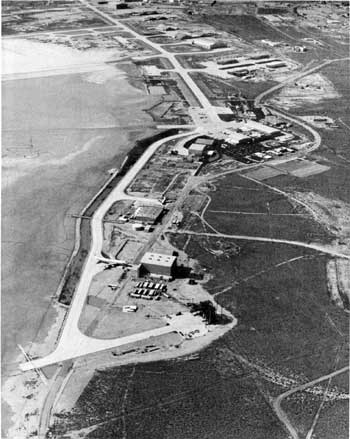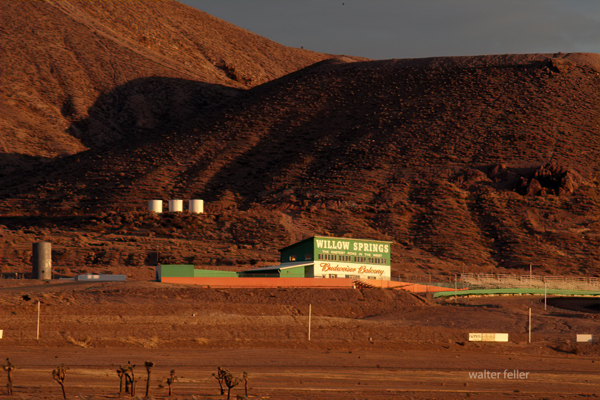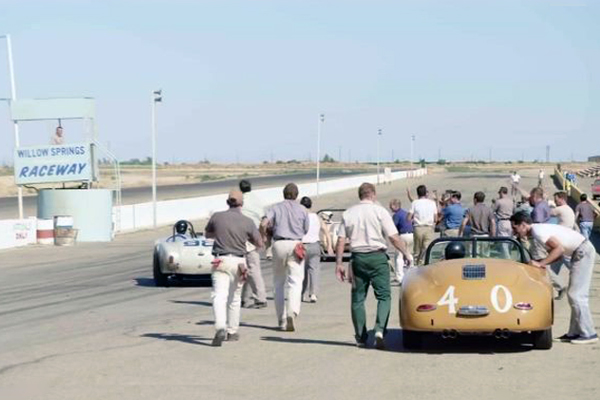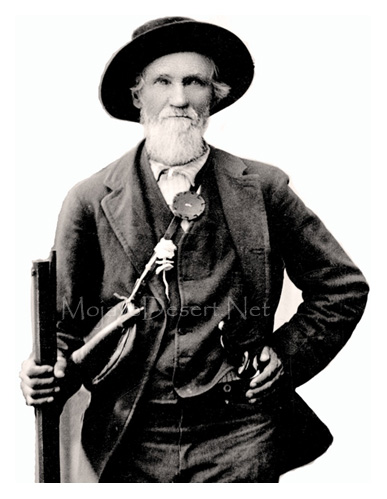The story of the aeronautics industry in Antelope Valley, California, is like a thrilling adventure packed with innovation, daring feats, and a community of passionate people pushing the boundaries of what’s possible.
The Early Days: A Desert Transformed

(Courtesy of NASA, NASA/Dryden Flight Research Center)
In the 1930s, Antelope Valley’s vast, quiet deserts started humming with activity as the Muroc Army Air Field, which would become Edwards Air Force Base, took root. The endless skies and isolated expanses were perfect for daring pilots to test new aircraft far from prying eyes.
World War II: A Boom of Innovation
Fast forward to the 1940s, and the skies over the Antelope Valley were buzzing with the energy of World War II. The desert became a crucible for innovation, with pilots and engineers working tirelessly to develop and test new aircraft that would give the Allies an edge.
Breaking Barriers: The Jet Age
Then came the post-war era and, with it, a leap into the unknown. In 1947, Chuck Yeager made history by breaking the sound barrier in the Bell X-1 at Edwards Air Force Base. Imagine the exhilaration of that moment—the roar of the jet, the shattering of records, and the sense of stepping into a new era of aviation.
The Space Race: Reaching for the Stars
The 1960s brought the space race, and the Antelope Valley became a launchpad for dreams of space exploration. NASA’s Flight Research Center at Edwards AFB buzzed with activity. Engineers and astronauts worked side by side, testing the limits of humans and machines. The X-15 rocket plane, for instance, soared to the edge of space, paving the way for the Apollo missions.
Modern Marvels: From Stealth to Space
The Antelope Valley continued to be a hotbed of innovation in the following decades. The 1980s and 1990s saw the development of stealth technology, leading to iconic aircraft like the B-2 Spirit bomber and the F-117 Nighthawk. Every test flight was a step into the unknown, with engineers and pilots working together to make the impossible possible.
The Commercial Space Age: New Horizons
As we moved into the 21st century, the Mojave Air and Space Port became a playground for the new pioneers of space—the private companies aiming to make space travel accessible to all. Think of the excitement as companies like Virgin Galactic and SpaceX took bold steps towards commercial spaceflight, testing rockets and spacecraft in the very place where aviation history had been made for decades.
A Community of Innovators
One thing remained constant throughout these eras: the spirit of the people in Antelope Valley. This community has been the heart and soul of aviation innovation, from the test pilots risking their lives to the engineers working late into the night to the local educators training the next generation of aerospace workers.
Milestones and Memories
The Antelope Valley is more than just a location; it’s a living testament to human ingenuity and endurance. It’s where the sound barrier was broken, the Space Shuttle first touched down, and new frontiers in aviation and space continue to be explored.
The story of the aeronautics industry in the Antelope Valley celebrates human achievement. It’s a narrative filled with high-flying dreams, ground-breaking successes, and the persistent pursuit of the skies and beyond.
Aeronautics Industry in Antelope Valley, California
The Antelope Valley, located in northern Los Angeles County and the southeast portion of Kern County in California, is a significant hub for the aeronautics industry. This region is often referred to as the “Aerospace Valley” due to its rich history and ongoing contributions to aviation and space exploration. Here are some key highlights about the aeronautics industry in the Antelope Valley:
- Edwards Air Force Base:
- Edwards AFB is a major center for flight testing and research. It is home to the Air Force Test Center and the Air Force Test Pilot School.
- Historically, it has been the site for testing experimental aircraft, including the X-1, in which Chuck Yeager broke the sound barrier, and the Space Shuttle, which landed here after its missions.
- NASA’s Armstrong Flight Research Center:
- Located within Edwards Air Force Base, this NASA center focuses on aeronautics research and testing advanced aircraft technologies.
- Notable projects include the testing of unmanned aerial vehicles (UAVs) and new propulsion systems.
- Mojave Air and Space Port:
- The Mojave Air and Space Port is a civilian aerospace test center and home to several private aerospace companies.
- Companies such as Virgin Galactic, Stratolaunch, and Masten Space Systems have conducted significant testing and development here.
- Plant 42:
- Air Force Plant 42 in Palmdale is another critical facility, serving as a production and testing site for major aerospace companies like Lockheed Martin, Northrop Grumman, and Boeing.
- It is known for the assembly and modification of aircraft, including the B-2 Spirit and the F-35 Lightning II.
- Aerospace Companies:
- Several prominent aerospace companies have a significant presence in the Antelope Valley. Northrop Grumman, Lockheed Martin, and Boeing all conduct major regional operations.
- These companies are involved in developing and testing cutting-edge technologies for military and civilian applications.
- Historical Significance:
- The region has a storied aviation history, from the early days of flight testing to the modern era of space exploration.
- It has played a crucial role in developing many iconic aircraft and spacecraft.
- Educational and Research Institutions:
- Institutions like Antelope Valley College, California State University, and Bakersfield offer programs related to aerospace and engineering, supporting the industry with a skilled workforce.
The Antelope Valley continues to be a cornerstone of innovation and progress in the aeronautics industry, playing a pivotal role in advancing aerospace technology and exploration.
Aviation Leaders in the Valley
The Antelope Valley has been home to numerous aviation leaders who have significantly contributed to advancing aerospace technology. These pioneers and visionaries have left an indelible mark on the industry, driving innovation and inspiring future generations. Here are some notable aviation leaders from the Antelope Valley:
- Chuck Yeager
Accomplishment: First person to break the sound barrier.
Contribution: On October 14, 1947, Yeager piloted the Bell X-1 at Edwards Air Force Base, achieving supersonic flight. His courage and skill made him an aviation legend and set the stage for future high-speed aircraft development. - Jack Northrop
Accomplishment: Founder of Northrop Corporation.
Contribution: Jack Northrop was a visionary engineer and designer known for his innovative aircraft designs, including the flying wing concept. His company played a crucial role in developing advanced military aircraft. - Kelly Johnson
Accomplishment: Founder of the Lockheed Skunk Works.
Contribution: Johnson was a brilliant aerospace engineer who designed iconic aircraft such as the U-2 spy plane, the SR-71 Blackbird, and the F-117 Nighthawk. His work at Skunk Works in Palmdale pushed the boundaries of stealth and reconnaissance technology. - Burt Rutan
Accomplishment: Founder of Scaled Composites.
Contribution: An innovative aerospace engineer, Rutan is known for designing SpaceShipOne, the first privately funded spacecraft to reach space. His work at the Mojave Air and Space Port has revolutionized the field of private space exploration. - George S. Patton Jr.
Accomplishment: WWII General and namesake of Patton Aviation.
Contribution: Although primarily known for his military leadership during World War II, Patton’s legacy extends to aviation through the Patton Aviation company, contributing to aviation training and services in the Antelope Valley. - Bill Dana
Accomplishment: NASA test pilot and astronaut.
Contribution: Dana was a key figure in testing the X-15 rocket plane, reaching the edge of space. His work helped bridge the gap between atmospheric flight and space travel, contributing significantly to the understanding of high-speed, high-altitude flight. - Frank Kendall
Accomplishment: Assistant Secretary of the Air Force for Acquisition.
Contribution: Kendall has played a vital role in developing and procuring advanced aerospace systems, ensuring the U.S. Air Force remains at the cutting edge of technology. His work has supported the Antelope Valley’s position as a leader in aerospace innovation. - Richard Branson
Accomplishment: Founder of Virgin Galactic.
Contribution: Branson’s company, Virgin Galactic, based at the Mojave Air and Space Port, is pioneering commercial space tourism. His vision and investment have opened new private space travel and exploration frontiers. - Elon Musk
Accomplishment: Founder of SpaceX.
Contribution: Though not based in the Antelope Valley, Musk’s SpaceX has conducted numerous tests and operations at the Mojave Air and Space Port. His leadership has accelerated the development of reusable rockets and the goal of making life multi-planetary. - James Webb
Accomplishment: NASA Administrator.
Contribution: Webb’s leadership during the Apollo program laid the groundwork for modern space exploration. The James Webb Space Telescope, named in his honor, represents the next generation of space exploration technology.
These leaders have each contributed uniquely to the aerospace industry, driving the boundaries of what is possible and cementing the Antelope Valley’s reputation as a cradle of aviation and space exploration innovation.










